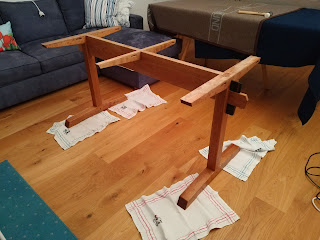 |
| The finished table. |
There were a few reasons this table took so long. The main one is I built it in Germany, when I live in Spain. We still own our place in Germany, and plan to go back there one day. In the meantime, we get back there every couple of months and I get a day or two to work on it. This time I had six or seven days to finish it.
The other reason it took longer than intended, is the wood for the base was changed from painted pine to American cherry. I love cherry, but it isn't quite as easy to work as pine. Also, I had to put a lot of brain power into matching wood grain for the laminations and stuff like that.
To start things off this time around I decided it was time to drawbore the leg assemblies together. After some testing, I decided to drive 13mm pegs into 1/2" holes. The measurments ensure that the peg is just a little oversize, and leaves a nice clean finish with no gaps.
 |
| Making drawbore pegs with my Austrian dowel plate. Sorry, neighbors! |
 |
| Surprisingly, all seven attempts survived the dowel plates. I sorted them and the best four are on the left. |
 |
| 13mm peg in 1/2" hole. |
Pretty much.
The next job was the decorative job of adding chamfers to every edge that will be exposed. I used a block plane and a Stanley #2 for this job.They worked well. I then used scrapers to get to the corners not reachable by the planes. I paid extra attention to the ends of the feet and upper supports so the corners look right.
 |
| Mock up after all the drawboring and chamfers. |
My buttons are 1 1/4" wide, so I made my mortises about two inches long. I used a 3/8" brad point bit, and started the mortise by putting the brad point in the center line. Then it was just a matter of drilling out the waste, and cleaning up the sides with a chisel. I left the ends of the mortises round to save a bit of work.
 |
| Cleaning up the sides of the mortise. |
 |
| This side done. I'll turn it over and do the other side. |
 |
| Base is done. |
 |
| Here's a shot showing the buttons installed. |
The only thing I didn't like about it was there were some tension cracks in the middle where the figure was the strongest. I decided to mix up some epoxy with some brown tint to fill the cracks in.
 |
| Epoxy is dry. This seems to be an efficient way to remove most of the extra. |
 |
| Here is that same spot after card scraping and a coat of tung oil. |
 |
| The finished table. |
If I could do something over on this table, it would be to re-think the tusk wedges. They look great and were fun to make. The problem is one glaring flaw: if they ever come loose, the top will have to be removed in order to tap them home again. Perhaps I can make some wedges to mitigate this, but I would have to say that this style of trestle isn't ideal because of that.
It's not enough to ruin the table. Perhaps next time some wedges that tap in from the side would be more appropriate.
Lastly is this unusual video. I'm now back in Spain, and the client will pick up the table next weekend and drive it about 1 1/2 hours to it's new home. Just to make sure she would be confident in putting it together, I made a video explaining every possible thing I could think she would need to know in it's assembly. I added it to this post as I thought you might get a kick out of it.
Note #2, I didn't really re-assemble this table after breaking it down. I taped everything in reverse order. I actually disassembled the table, and re-arranged the video clips to show it coming together. Only one screw has been in it's hole more than once. It was fun trying to think what I was going to say in the next segment so I didn't sound like an idiot saying everything twice.
Let me know if you like the video, perhaps I will do more in the future.
Here are links to all of the posts from this build:
Part I
Part II
Part III
Part IV
Part V
Part VI
Part VII
Part VIII
Part IX

















